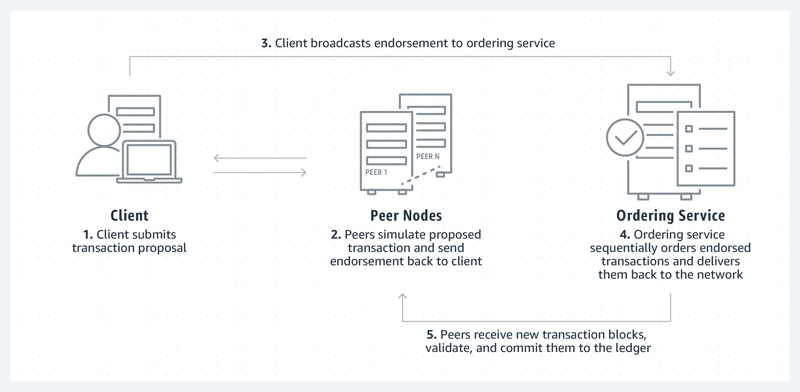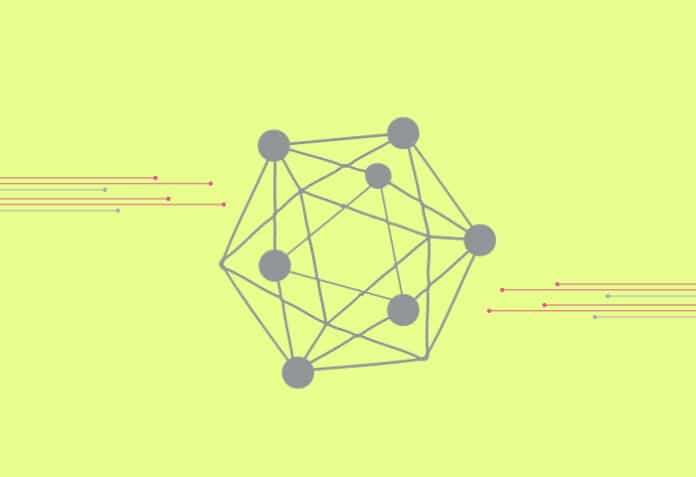Understanding the essential features of Hyperledger Fabric is crucial for anyone looking to develop blockchain applications for enterprise use. These features provide the foundation for building secure, scalable, and privacy-focused applications, and can be leveraged to create innovative solutions that address real-world business challenges.
Blockchain technology has rapidly gained popularity across various industries for its secure and transparent nature. Hyperledger Fabric, one of the most prominent blockchain frameworks, stands out for its robust features and flexibility. Designed for enterprise use, it is part of the Hyperledger project hosted by The Linux Foundation and is one of the most popular blockchain frameworks for developing business applications.
How does it work?
At its core, Hyperledger Fabric works by creating a network of unique organisations that interact with each other. Each organisation has its own Fabric certificate authority (CA) and one or more peer nodes. The Fabric CA issues certificates for users and manages permissions, while peer nodes endorse transactions, execute smart contracts (Chaincode), and store a local copy of the ledger.
Transactions in Hyperledger Fabric are initiated by clients and endorsed by endorsing peers. These endorsed transactions are then ordered into blocks by the ordering service, which is shared by all organisations in the network. The ordering service ensures that transactions are properly ordered and broadcasts new blocks to peer nodes. Peer nodes validate the transactions in the block and update their local copy of the ledger accordingly.
Hyperledger Fabric as a blockchain framework
Hyperledger Fabric is a blockchain framework designed for developing enterprise-grade applications. It provides a modular architecture that allows organisations to customise various components, such as consensus algorithms, membership services, and smart contract execution environments.
Fabric’s key features include permissioned network, privacy and confidentiality, scalability, smart contracts (Chaincode), endorsement policies, pluggable consensus, identity management, rich querying, and interoperability. These features make Fabric well-suited for building secure and scalable blockchain applications for enterprise use.
The essential features of Hyperledger Fabric
Here’s a detailed overview of each feature of Hyperledger Fabric.
Modularity: Hyperledger Fabric’s modular architecture allows for flexibility and customisation by breaking down the blockchain network into independent components. These components, such as the ordering service, peer nodes, and membership service provider (MSP), can be customised or replaced to meet specific business requirements. For example, organisations can integrate their consensus algorithms or use different databases for storing ledger data, enhancing the network’s scalability and performance.
Permissioned network: Hyperledger Fabric operates on a permissioned network, where participants must be authenticated and authorised to access the network. This enhances security and privacy by ensuring that only trusted parties can participate in the network. Permissioned networks also enable organisations to comply with regulatory requirements by controlling access to sensitive information.
Smart contracts (Chaincode): Smart contracts in Hyperledger Fabric are implemented using Chaincode, which is a piece of code that defines the rules and logic of transactions. Chaincode is executed on the peers in a secure and isolated environment, ensuring that unauthorised parties cannot tamper with or modify it. This enables automated and trustless execution of transactions, reducing the risk of fraud and errors.
Consensus mechanism: Hyperledger Fabric supports a pluggable consensus mechanism, allowing organisations to choose the consensus algorithm that best suits their needs. This provides flexibility in terms of performance, scalability, and fault tolerance. For example, organisations can choose between the default Kafka-based ordering service or use alternative algorithms like Raft or PBFT for ordering transactions.
Privacy and confidentiality: Hyperledger Fabric ensures the privacy and confidentiality of transactions through channels and private data collections. Channels allow for the creation of private sub-networks within the main network, where only selected participants can access and transact. Private data collections enable parties to store sensitive information off-chain, ensuring it is only shared with authorised parties.
Identity management: Identity management is crucial in blockchain networks to ensure that participants are who they claim to be. Hyperledger Fabric uses the MSP component to manage identities, providing authentication and authorisation services. MSP allows organisations to define their identity management policies, ensuring that only authorised users can access the network.
Scalability: Hyperledger Fabric is designed to be highly scalable, supporting thousands of transactions per second. This is achieved through its modular architecture, which allows for the parallel execution of transactions and using off-chain data storage solutions. Additionally, Hyperledger Fabric supports horizontal scaling, enabling organisations to add more nodes to the network as the demand for transactions increases.
Interoperability: Hyperledger Fabric can interoperate with other blockchain networks and legacy systems through its support for standard protocols and interfaces. For example, it supports the Hyperledger Cactus project, which provides interoperability between different blockchain platforms. This enables organisations to integrate Hyperledger Fabric into existing infrastructure and collaborate with other blockchain networks.
Table 1: A comparison with other blockchain frameworks
| Feature | Hyperledger Fabric | Ethereum | Bitcoin |
| Network type | Permissioned | Permissionless | Permissionless |
| Privacy and confidentiality | Supports private transactions and confidentiality | Public ledger | Public ledger |
| Smart contracts | Chaincode (supports multiple languages) | Solidity (specific to Ethereum) | Bitcoin Script (limited scripting language) |
| Consensus mechanism | Pluggable consensus (e.g., Raft, Kafka) | Proof of Work (PoW) | Proof of Work (PoW) |
| Scalability | Modular architecture allows for scalability | Challenges with scalability | Challenges with scalability |
| Identity management | Provides robust identity management capabilities | Limited identity management capabilities | Limited identity management capabilities |
| Customisation | Highly customisable | Less customisable | Less customisable |
| Use cases | Enterprise applications, supply chain management, identity management | Decentralised applications, tokenisation, decentralised finance | Digital currency, peer-to-peer transactions |
Use cases of Hyperledger Fabric
Here are a few examples of how Hyperledger Fabric is being used in various industries.
1. Supply chain management: Hyperledger Fabric is revolutionising supply chain management by providing a transparent and efficient way to track products from their origin to the end consumer. For instance, in the agriculture sector, Hyperledger Fabric is used to trace the journey of produce from farms to store shelves, ensuring its authenticity and quality. This helps in identifying and addressing issues such as contamination or spoilage, leading to safer and more reliable food supply chains.
- Ensures authenticity and quality of products
- Identifies and addresses issues like contamination or spoilage
- Improves supply chain transparency and efficiency
2. Healthcare: In the healthcare industry, Hyperledger Fabric is transforming how patient data is managed and shared. By using blockchain technology, healthcare providers can securely store and share patient records, ensuring data privacy and integrity. For example, hospitals are using Hyperledger Fabric to create a unified and secure patient database, enabling authorised healthcare professionals to access patient information quickly and accurately, leading to improved patient care and outcomes.
- Ensures data privacy and integrity
- Enables quick and accurate access to patient information
- Streamlines healthcare processes and improves efficiency
3. Finance and banking: Hyperledger Fabric is reshaping the finance and banking sector by providing a secure and transparent platform for financial transactions. For instance, in cross-border payments, Hyperledger Fabric is used to facilitate faster and more cost-effective transactions between banks and financial institutions. Additionally, Hyperledger Fabric is used for trade finance, enabling secure and efficient transactions between buyers and sellers across the globe. This has the potential to revolutionise international trade by reducing the time and cost associated with traditional trade finance processes.
- Facilitates faster and cost-effective transactions
- Enables secure and efficient trade finance processes
- Enhances transparency and reduces fraud in financial transactions
4. Government: Governments are leveraging Hyperledger Fabric for various applications, including identity management and public service delivery. For instance, in identity management, governments use Hyperledger Fabric to create secure and tamper-proof digital identities for citizens. This helps in reducing identity theft and fraud, while also improving access to government services. Moreover, Hyperledger Fabric is being used for land registry, enabling governments to create a transparent and secure system for recording land ownership, leading to more efficient land management and reduced disputes.
- Reduces identity theft and fraud
- Improves access to government services
- Enhances transparency and efficiency in government operations
1. Honeywell
Industry: Diversified materials and products
Overview: Honeywell implemented Hyperledger Fabric to enhance the traceability and transparency of its supply chain for materials and products. By utilising blockchain technology, Honeywell can track the origin of raw materials, monitor manufacturing processes, and ensure the authenticity of its products.
Results: The use of Hyperledger Fabric has enabled Honeywell to improve supply chain efficiency, reduce counterfeit products, and enhance trust among customers and stakeholders.
2. Bosch
Industry: Automobiles and auto parts
Overview: Bosch adopted Hyperledger Fabric to streamline its supply chain processes for automobile components. By digitising the supply chain, Bosch can track the movement of parts from suppliers to assembly lines, improve inventory management, and enhance quality control.
Results: The implementation of Hyperledger Fabric has enabled Bosch to reduce lead times, optimise inventory levels, and improve the overall efficiency of its supply chain operations.
3. NP Solution Limited
Industry: Human resources and staffing
Overview: NP Solution Limited deployed Hyperledger Fabric to create a decentralised platform for managing human resources and staffing services. The platform enables transparent and secure management of employee records, as well as payroll and recruitment processes.
Results: The use of Hyperledger Fabric has helped NP Solution Limited streamline HR processes, improve data security, and enhance trust among clients and employees.
4. IBM
Industry: Information technology and services
Overview: IBM leveraged Hyperledger Fabric to develop blockchain solutions for various industries, including finance, healthcare, and supply chain management. IBM’s blockchain offerings enable clients to digitise and secure their business processes, improve transparency, and reduce operational costs.
Results: IBM’s use of Hyperledger Fabric has enabled clients to achieve greater efficiency, security, and transparency in their business operations, leading to improved customer satisfaction and competitive advantage.
5. Walmart
Industry: Retail corporation
Overview: Walmart partnered with IBM to implement Hyperledger Fabric in its food traceability initiative. By digitising the supply chain, Walmart can track the journey of food products from farm to store shelves. This enables quick identification of the source of contamination in case of food safety issues, reducing food waste and enhancing consumer trust.
Results: The use of Hyperledger Fabric has significantly improved food safety standards at Walmart. The company can now quickly identify and remove contaminated products from its shelves, reducing the risk of foodborne illnesses and ensuring customer safety.

Creating a Hyperledger Fabric blockchain network: Get started
Step 1: Install prerequisites
Ensure you have the necessary software installed, such as Docker and Node.js.
# Install Docker (if not already installed) curl -fsSL https://get.docker.com -o get-docker.sh sudo sh get-docker.sh # Install Node.js and npm (if not already installed) sudo apt-get install nodejs npm
Step 2: Download fabric samples
Clone the Hyperledger Fabric samples repository from GitHub.
# Clone the Hyperledger Fabric samples repository from GitHub git clone https://github.com/hyperledger/fabric-samples.git
Step 3: Generate the artifacts
Use the provided scripts to generate the cryptographic material and configuration artifacts.
# Navigate to the first-network directory within the fabric-samples directory cd fabric-samples/first-network # Generate the cryptographic material and configuration artifacts using the byfn.sh script ./byfn.sh generate
Step 4: Start the network
Use Docker Compose to start your network with the generated artifacts.
# Start the network using Docker Compose./byfn.sh up
Step 5: Run your first application
Use the provided sample applications to interact with your Hyperledger Fabric network.
# Navigate to the chaincode-docker-devmode directory within the fabric-samples directory cd ../chaincode-docker-devmode # Install the required Node.js dependencies npm install # Start the application using Docker Compose docker-compose -f docker-compose-simple.yaml up
In conclusion, adopting Hyperledger Fabric is not just a choice; it’s a strategic decision that can redefine the way businesses operate in the digital age. For developers, mastering this platform opens doors to innovative solutions that are secure, scalable, and tailored to modern challenges. For businesses, understanding Hyperledger Fabric is a pathway to efficiency, transparency, and a competitive edge in an increasingly digital world.




